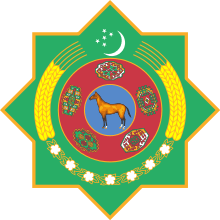Tourism in Turkmenistan
Turkmenistan is a country with big potential for an expanded tourism industry. Many of its central Asian cities were main points of trade on the Silk Road, linking Eastern and Western civilizations. Many neighboring countries (including Kazakhstan, Uzbenkistan and Iran) promote their countries based on their location along the Great Silk Road. Tourism has grown rapidly in recent years. Tourists from abroad are deterred by the restrictive visa regime with all countries of the world. Tourism is regulated by the Tourism Committee of Turkmenistan.
Historical sights

The sights of World Heritage Sites in Turkmenistan was listed 3 items.
Nisa (also Parthaunisa) was an ancient city, located near modern-day Bagir village, 18 km southwest of Ashgabat. Nisa is described by some as one of the first capitals of the Parthians. It is traditionally assumed to be founded by Arsaces I (reigned c. 250 BC–211 BC), and was reputedly the royal necropolis of the Parthian kings, although it has not been established that the fortress at Nisa was either a royal residence or a mausoleum.
Merv formerly Achaemenid Satrapy of Margiana, and later Alexandria and Antiochia in Margiana, was a major oasis-city in Central Asia, on the historical Silk Road, located near today's Mary. Several cities have existed on this site, which is significant for the interchange of culture and politics at a site of major strategic value. It is claimed that Merv was briefly the largest city in the world in the 12th century.[1]
Konye-Urgench is a municipality of about 30,000 inhabitants in north-eastern Turkmenistan, just south from its border with Uzbekistan. It is the site of the ancient town of Ürgenç, which contains the unexcavated ruins of the 12th-century capital of Khwarezm. Since 2005, the ruins of Old Urgench have been protected by UNESCO as a World Heritage Site.[2] (See List of World Heritage Sites in Turkmenistan)
Resorts and nature tourism
The warm Caspian Sea coast of Turkmenistan is the site for a number of popular sea resorts, like Avaza, known for its beaches and wonderful nature.
Wildlife areas in the desert and other attractions
Desert fauna of Karakum includes many kinds of rare animals. There is a Karakum nature reserve at the flood-land drained by the Amu Darya.

Near Derweze village in the middle of the Karakum Desert is a natural gas deposit. While drilling in 1971, Soviet geologists tapped into a cavern filled with natural gas.[3] The ground beneath the drilling rig collapsed, leaving a large hole with a diameter of 70 metres (230 ft) at 40°15′10″N 58°26′22″E / 40.25264°N 58.43941°E. To avoid poisonous gas discharge, it was decided the best solution was to burn it off.[4] Geologists had hoped the fire would use all the fuel in a matter of days, but the gas is still burning today. Locals have dubbed the cavern "The Door to Hell".[5]
Accessibility of the country
Most trips to Turkmenistan begin with arrival at the capital Ashgabat or the seaside town Turkmenbashi. Ashgabat has a modern international airport, which is the base of Turkmenistan Airlines. The airport is served by Lufthansa, S7 Airlines, Turkish Airlines, Flydubai, Belavia and China Southern Airlines. Another three airports in Turkmenistan (Turkmenabat, Mary and Turkmenbashi) have international status. Because of current restrictions tickets for domestic flights cannot be booked or purchased more than 14 days prior to departure.
Museums
Most of the museums are located in the major cities of Turkmenistan such as Ashgabat, Turkmenabat, Balkanabat, Mary and Dazhoguz . Some of these include:
- Ashgabat National Museum of History
- Mary Museum
- The main museum of Turkmenistan
- Turkmen Carpet Museum
- Turkmen Museum of Fine Arts
Foreign visitor arrivals in 2012
The three following countries had the most tourists visiting Turkmenistan in 2012:[6]
 Iran: 3874
Iran: 3874 Germany: 1143
Germany: 1143 United States: 531
United States: 531
References
- ↑ Largest Cities Through History
- ↑ "Kunya-Urgench". UNESCO World Heritage Center. UNESCO. Retrieved 19 February 2011.
- ↑ http://www.gadling.com/2008/03/25/turkmenistans-door-to-hell/
- ↑ http://englishrussia.com/?p=1830
- ↑ http://yourenotfromaroundhere.com/blog/hell-is-great-hell-turkmenistan/
- ↑ Statistics
See also
External links
| Wikivoyage has a travel guide for Turkmenistan. |
- (English) (Russian) (Turkmen) Official state web-site of the Tourism Committee of Turkmenista
| |||||||||||||||||||||||||||||||||||||||||
| ||||||||||||||
